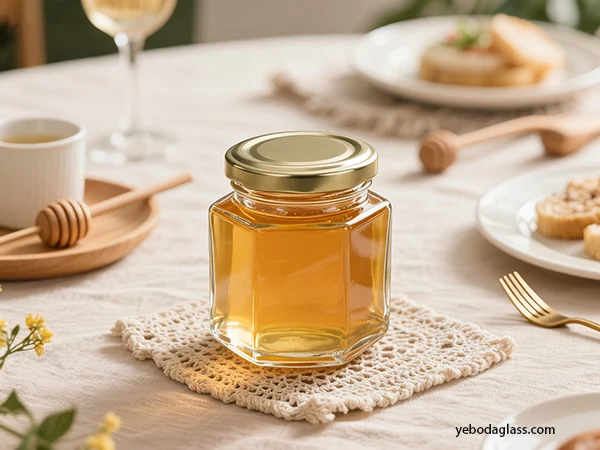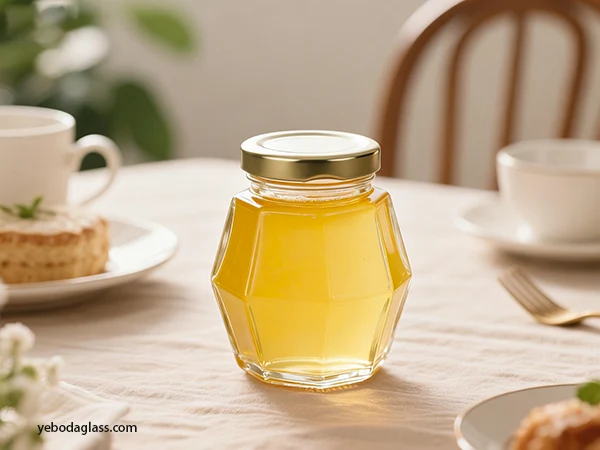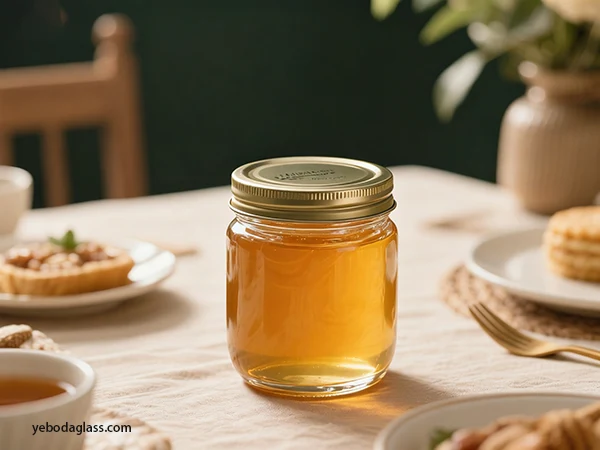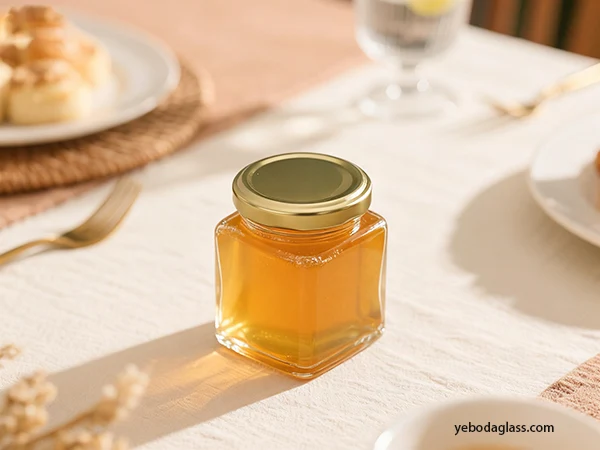Introduction
Honey, a globally traded commodity, requires packaging that preserves its unique qualities and meets international standards. In this complex landscape, glass honey jars have emerged as the preferred packaging solution for frequent exports. The glass honey jars from Yeboda provide superior durability, aesthetic appeal, and adaptable designs, enhancing brand value and consumer perception. This report examines the multifaceted reasons behind the dominance of glass, analyzing the key factors that elevate its priority over other options. It offers a comprehensive understanding of why glass honey jars remain the gold standard for honey export packaging through comparative analysis, a stakeholder approach, regional impact studies, and economic and environmental evaluations. The report provides a detailed, expert-level analysis of the physics, market dynamics, and regulatory structures shaping international honey packaging decisions.

Comparative Analysis of Glass vs Alternative Packaging Material for Honey Export
The choice of packaging materials for honey exports severe product integrity, marketing capacity and logical efficiency. While various materials are available, glass jars consistently perform better than options in several major matrix. This section gives a description of a comparative analysis of glass honey jar against common options: plastic (PET, HDPE), metal (tinplate), and flexible pouch.
Glass Packaging
Benefit:
- Inertia: glass is chemically passive, preventing reaction with honey or leaching, purity, taste and nutritional profile to maintain paramount, especially for raw or organic honey.
- Barrier Properties: Glasses provide a complete obstruction to gases, moisture and odors, preventing oxidation, moisture changes and contamination, which greatly expands the shelf life.
- Transparency: Glass clarity allows consumers to observe the product, its natural color, stability and any crystallization, often indicating quality for raw honey.
- Premium Perception: Glass expresses quality, tradition and a sense of luxury, increasing the alleged value of honey.
- Recruitment: The glass is 100% and is infinitely recycled without quality loss, a highly durable option where the infrastructure exists.
- Hardness and Security: provides excellent protection against physical damage and molestation.
Loss:
- Weight: Glass is much heavier than plastic or flexible pouches, causing high shipping costs and increases carbon footprint during transport.
- Dryt: Glass is susceptible to braking, which requires strong secondary packaging and careful handling, which adds cost and logical complexity.
- Energy Consumption: The production of new glass is energy-intensive, although it is reduced by high recycling rates.
Polyethylene Terraphhelet (PET)
PET is a common plastic used for food packaging, which includes some honey products, especially in domestic markets or for large bulk versions.
Benefit:
- Light, durable, transparent and recycled.
Loss:
- Barrier properties are less than glass.
- Leaching concerns (speculative) premium can affect the perception for honey.
- Environmental effects from fossil-fuel etymology.
High Density Polyethylene (HDPE)
- Benefits: Durable, flexible, light, cost effective.
- Disadvantages: poor barrier properties, opaque, leaching perception, environmental effects.
Tinplate (Metal Cans)
- Benefits: absolute barrier, durable, stacked.
- Disadvantages: opaque, heavy, denting, corrosion risk compared to plastic.
Flexible Pouches
- Benefits: Extremely light, low material use, feature, space efficiency.
- Disadvantages: The barrier properties are considered inferior, budget -friendly, recycling challenges, low physical safety, limited visual appeal.
In summary, while options provide weight and durability benefits, they often compromise inertia, obstructive properties and premium perception. For export markets, these compromises strengthen the preference for glass honey jars, honey containers and glass bottles.
Critical Factors Driving Glass Preference in Honey Export
Superior Food Safety: Inertness and Non-Leaching Properties
Glass’s unparalleled food safety profile is a compelling argument. As an amorphous solid, it is chemically inert and non-porous:
- No chemical interaction with honey’s sugars, enzymes, amino acids, vitamins, and minerals.
- No leaching of harmful chemicals (e.g., phthalates, BPA).
- Maintains purity for raw, organic, and specialty honey.
Extended Shelf Life: Unrivaled Barrier Properties
Glass provides an absolute barrier against:
- Oxygen, preventing oxidation.
- Moisture, maintaining ideal consistency.
- Odors, protecting delicate aroma.
- UV light (for colored glass), preventing degradation.
Premium Market Perception: Aesthetics and Perceived Quality
- Clarity allows consumers to appreciate honey color, viscosity and crystallization.
- Expresses quality, tradition and luxury.
- Custom Glass Honey Jar jar enables discrimination through shapes and embossing (eg, adaptable jar of Yeboda).
- Ideal to give gifts, to increase market appeal.

Strong Compliance with International Regulatory Standards
- Universally accepted by FDA, EFSA and other regulators.
- Labeling facilitates transparency.
- Maintains integrity for raw, organic, manuka and special honey certificates.
Stakeholder Perspective on Glass Packaging for Exports
End Consumer: Alleged Price, Revellable and Faith
Consumers are at the center of the market, and their preferences give significant shape to packaging decisions.
- Recognized price and quality: Glass is internally associated with quality, purity and premium. Consumers in rich export markets often pay more for glass honey jars. Glass honey jar of Yeboda provides a premium touch and visual appeal, strengthening the brand trust.
- Food safety and health concerns: glass ensures food safety, the chemical migration found in some plastic avoids concerns.
- Re -purpose and stability: glass jars are appreciated for storage, crafts, or refilling, environmental perception.
- Sensory experience: Weight and experience of glass jar increases the experience of unboxing and consumption.
Importers/Distributors: Handling, Storage, and Marketability
- Marketing and sales: Glass-packed honey makes better sales in the premium segment; Beauty runs the appeal status.
- Product integrity during transit: The obstruction properties of glass jars ensure that honey comes in ancient condition.
- Storage stability: Honey remains fresh for a long time, supports inventory management.
- Handling (with caves): Established glass logistics and secondary packaging managed delicateness.
Regulators: Security, labeling and Compliance
- Food Safety Assurance: Glass is a globally recognized safe food contact material.
- Transparency and Traceability: Clear labeling and visual inspection aid regulator compliance.
- Environment Regulations: Anant recycling circular economy aligns with initiative.
Manufacturers: Processing, Branding and Operations Efficiency
- Product protection: Maintains the quality of honey in the glass supply chain.
- Branding and discrimination: Customable Yaboda Glass Honey Jar enhances brand identity.
- Filling and sealing efficiency: compatible with standard filling/sealing equipment.
- Long-term cost-benefit: premium pricing and replenishing poor high unit costs.
- Stability target: Recycled glass supports environmental initiative.
Regional and Market-Specific Influences on Glass Packaging Adoption
Developed Markets (e.g., North America, Western Europe, Australia, Japan)
- Strong premium segment aligns with glass honey jars.
- High environmental consciousness favors recyclable glass.
- Robust regulations support inert materials.
- Established infrastructure mitigates handling disadvantages.
- Cultural preference for glass reinforces consumer expectations.
Emerging Markets (e.g., parts of Asia, Latin America, Eastern Europe)
- Balanced price sensitivity by aspiring consumers evaluating premium products.
- Developing a recycling infrastructure limits environmental gains but the product preserves safety.
- Food security concerns are in favor of glass.
- E-commerce growth requires strong packaging for final mile delivery.
Specific Market Niches (eg, Organic, Raw, Manuka Honey)
- Glass ensures unrelated accuracy for high-value honey.
- Premium provides the facility of branding and storytelling.
- The niche justifies high value points for markets.

Contrarian View: Bulk and Industrial Markets
Bulk honey often uses HDPE or metal containers for cost-efficiency. Aesthetic appeal is secondary, glass preference is retail-focused.
Economic and Environmental Considerations of Glass in Honey Export
Economic Considerations
- Unit Cost: Glass is higher than plastic alternatives.
- Shipping Weight and Costs: Heavier weight increases freight costs.
- Breakage Rates and Secondary Packaging: Adds cost and labor.
- Handling and Labor Costs: Glass requires careful handling or automation.
- Premium Pricing Potential: Glass honey jars enable higher price points, often offsetting costs.
- Long-Term Value: Extended shelf life reduces spoilage and waste.
Environmental Considerations
- Recycled and circular economy: Glass is infinitely recycled.
- Carbon footprints (production and transport): High energy use and weight losses; The recycled material reduces the effect.
- Resources shortage: Glass raw materials are abundant; Recycling reduces extraction effects.
- Marine pollution: Glass avoids microplastics issues.
- Use of water: Important during manufacturing.
Balance Act and Future Outlooms
- Lightweight: Weight, material and shipping reduces footprints.
- Advanced Coatings: Increase durability and reduce rupture.
- Customized logistics: Efficient supply chains reduce weight loss.
- Closed Loop Systems: Deposit-retrurn/refill models improve stability.
Future Outlook and Innovations in Honey Export Packaging
Continued Dominance of Glass with Enhancements
- Lightweighting technologies reduce material and shipping costs.
- Enhanced durability via surface coatings minimizes breakage.
- Increasing recycled content reduces energy footprint.
- Smart packaging integration (e.g., QR codes, temperature-sensitive labels) may emerge.
Emergence of Advanced Alternative Materials
- Bio-based and biodegradable plastics could become viable if barrier and inertness standards meet glass-level requirements.
- Advanced barrier plastics with multi-layer or coating technologies may compete but face recyclability challenges.
- Paper-based bottles with food-safe liners are highly speculative.
Evolving Consumer and Regulatory Demands
- Hyper-sustainability focus, transparency, and traceability will grow.
- Refill and reuse models will increase.
- Plastic bans and taxes globally encourage glass adoption.
Contrarian Ideas and Disruptions (Speculative)
- Edible packaging, decentralized 3D printing, and “naked” products are futuristic alternatives.
- Glass will likely remain dominant for premium honey exports due to its combined attributes.

Conclusion: Reinforcing the Preference for Glass in Honey Export
The analysis confirms strategic benefits and permanent preference for glass honey jars in international export markets.
- Food Security: Chemical inertia preserves honey taste, aroma and nutrients.
- Extended Shelf Life: Absolute barrier properties protect against oxygen, moisture and odor.
- Market Perception: clarity and touch experience expresses premium quality and luxury; Yeboda’s glass honey jar brand increases discrimination and consumer appeal.
- Stakeholder Alignment: End consumers, distributors, regulators, and producers are all benefited from glass packaging.
- Economic and Environmental Views: High cost and weight premium pricing, low deterioration and infinite recycling are offset.
- Future Approaches: Lightweight, increased durability, recycled materials, and stability innovations will further strengthen the condition of the glass, while alternative material develops.
Finally, glass honey jars are not only containers, but are integral to identify honey, ensure quality, increase market appeal, and achieve their place in the global market.




